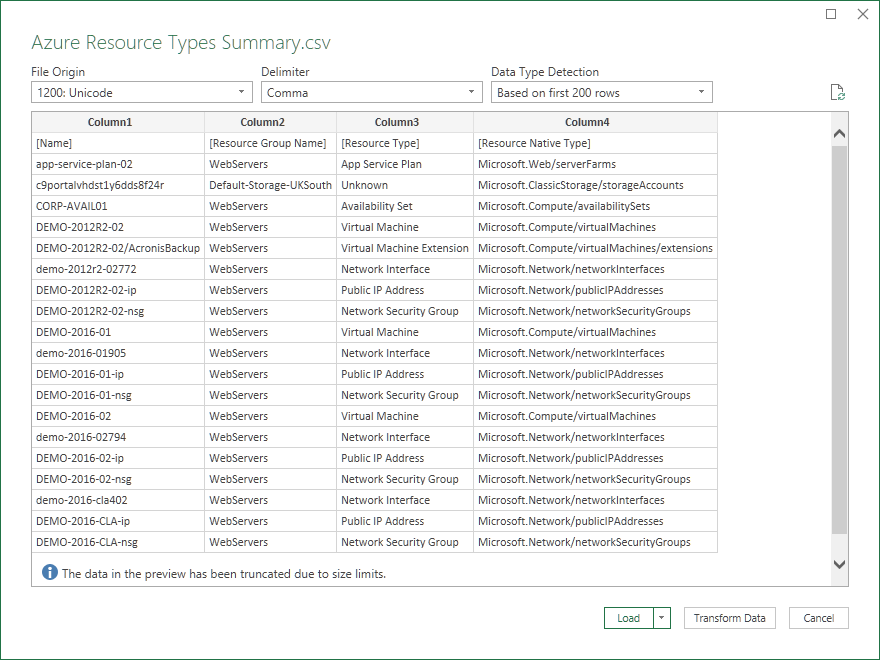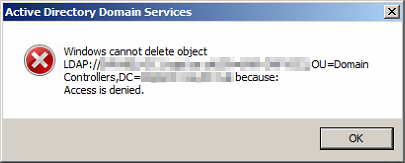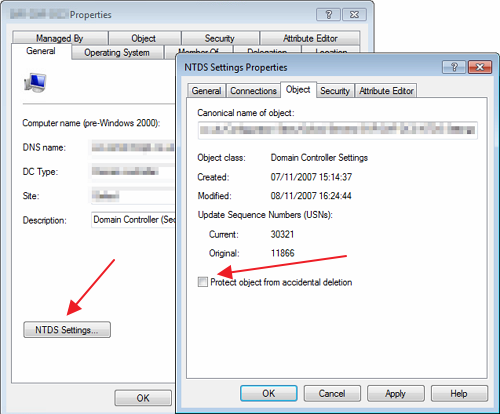This post describes how to fix the error:
Windows cannot delete object LDAP://... because: A referral was returned from the server.
Cause
This error occurred when I was trying to delete a domain controller using Active Directory Sites and Services. The domain controller was part of a child domain which I had demoted.
Resolution
I force deleted the server using ADSIEdit:
1. Open ADSI Edit.
2. Right click the ADSI Edit root node in the tree view on the left then select Connect to…
3. In Connection Settings, change the Naming Context to Configuration then press OK

4. Navigate down to CN=Servers then right click the server you want to delete and select Delete

Related Posts
— The time between replications with this source has exceeded the tombstone lifetime
— The operation failed because spn value provided for addition/modification is not unique forest-wide
— Error 0x2015(The directory service can perform the requested operation only on a leaf object.)
— Group Policy Audit & Reporting Tool
Popular posts from this blog
LG TV This app will now restart to free up more memory
This post describes how to fix the error «This app will now restart to free up more memory» which can occur when using apps such as Netflix on an LG TV after just a few minutes of use. Resolution To resolve the issue, unplug the TV then press the on/off button for 10 seconds. Wait a further 20 seconds then plug the TV back in and turn it back on. Apps should now run without the error. Edit: The on/off button on my LG TV is directly under the standby light on the bottom of the TV. Edit: I didn’t have to do this myself but one person who has left a comment said that clearing all browsing data worked for them. I have written a post explaining how to do this: LG TV Clear All Browsing History Data . Edit: A few other people have also suggested turning off quick start in settings (and if it’s already off, turn it on then off again). I have written a post explaining how to do this: LG TV turn off Quick Start in settings Related Posts — LG TV delete/rem…
Excel Import CSV not using «Use First Row as Headers»

Issue When importing a CSV file into Microsoft Excel, you may find that it is not using «Use First Row as Headers» so you end up with Column1, Column2 etc as headers. Resolution To resolve this issue, press the Transform Data button in the bottom right. This loads the Power Query Editor which includes the «Use First Row as Headers» option in the Home ribbon. Press this option once. Press Close & Load to apply. The first row is now being used as headers: Related Posts — Open a Microsoft Excel spreadsheet xlsx file as read only
What is the «W» light on a Steelseries keyboard?

This post describes what the light marked «W» on a Steelseries Apex keyboard is. This is the fourth light in the row located in the top right corner of the keyboard, next to the Scroll Lock «S» light. The «W» light on a Steelseries Apex Keyboard This light indicates that the Windows key has been disabled. So, when you’re gaming, if you accidentally press the Windows key, you will stay in the game instead of being taken to the Windows desktop. How to turn the «W» light on or off? The «W» light on a Steelseries Apex keyboard can be turned on or off by pressing and holding the special Steelseries function key down, then pressing the Windows key. Related Posts — Steelseries Sensei Ten squeaky scroll wheel
Deleting an orphaned Active Directory Domain Controller fails with error:

Windows cannot delete object LDAP:// ……………………
Access is denied.
First obvious step is to make sure that your user account has permissions to delete objects in the OU in question.
If user permissions are not the problem, check that computer object you are deleting and any objects contained within it are not protected from accidental deletion. Right click on the object, go to Properties > Object and make sure that the checkbox next to “Protect from accidental deletion” is not checked.
If you can’t see Object tab, enable “Advanced Features” in the View menu.
To be able to see sub-objects, also check “Users, Contacts, Groups, and Computers as containers“.
Also click on “NTDS Settings” in General tab of DC object Properties. Make sure that “Protect from accidental deletion” is not checked.

Windows Server 2008 R2
Error Windows Cannot Delete Object Ldap It System Administrator Tuts When i use aduc locally on my computer and tell it to delete using same steps as listed above, i receive this message, «windows cannot delete object. ldap: dc.domain cn=old dc,ou=domain controllers, dc=domain, dc=com because: the specified module could not be found.». Windows cannot delete object ldap : name of my server and container of old server dc. access is denied. in windows server 2008 r2, we can achieve to clear the metadata of orphaned domain controller by simply deleting the dc server object in active directory.
Error Windows Cannot Delete Object Ldap It System Administrator Tuts This article helps resolve an issue in which you can’t edit or delete an active directory (ad) object and receive the error «attribute is owned by the security accounts manager (sam)» or «the specified account does not exist.». Couldn’t find anything in adsi edit and could not delete them manual. i would get an error with «windows cannot delete object ldap a referral was returned from the server» when i tried to delete the dc domain in sites and services. Thanks for the help, but mentioned in the original post that i am unable to delete ntds settings due to an error. the actual error is “windows cannot delete object ldap: dcy… because: a referral was returned from the server.” nothing is set to be prevented from accidental deletion. How do i delete this orphaned active directory computer object (preferably with powershell)?.
Error Windows Cannot Delete Object Ldap It System Administrator Tuts Thanks for the help, but mentioned in the original post that i am unable to delete ntds settings due to an error. the actual error is “windows cannot delete object ldap: dcy… because: a referral was returned from the server.” nothing is set to be prevented from accidental deletion. How do i delete this orphaned active directory computer object (preferably with powershell)?. When i try to delete it through adsi edit or ldp.exe i get the follow error message: deleting «cn=accountname,ou=xxx,dc=domain,dc=com» error <50>: failed to delete ‘cn=accountname,ou=xxx,dc=domain,dc=com.’ {insufficient rights}. At this point i would like to forcefully remove the dc and the subsite. i’ve tried the metadata cleanup method but receive the following error: metadata cleanup: remove selected server xxxx binding to localhost … connected to localhost using credentials of locally logged on user. ldap error 0x22(34 (invalid dn syntax). Active directory windows cannot delete object because: the specified directory service attribute or value does not exist. this problem occurs when your user or group account has «list contents» permission on the parent of the object you’re viewing but you don’t have rights for the object itself. You get the following error as administrator (who has rights to the whole forest, domain, and ou that the object is in. «the active directory object could not be displayed. \n unable to view attribute or value. you may not have permissions to view this object.» when you try to delete the object you get «windows cannot delete object.
Error Windows Cannot Delete Object Ldap It System Administrator Tuts When i try to delete it through adsi edit or ldp.exe i get the follow error message: deleting «cn=accountname,ou=xxx,dc=domain,dc=com» error <50>: failed to delete ‘cn=accountname,ou=xxx,dc=domain,dc=com.’ {insufficient rights}. At this point i would like to forcefully remove the dc and the subsite. i’ve tried the metadata cleanup method but receive the following error: metadata cleanup: remove selected server xxxx binding to localhost … connected to localhost using credentials of locally logged on user. ldap error 0x22(34 (invalid dn syntax). Active directory windows cannot delete object because: the specified directory service attribute or value does not exist. this problem occurs when your user or group account has «list contents» permission on the parent of the object you’re viewing but you don’t have rights for the object itself. You get the following error as administrator (who has rights to the whole forest, domain, and ou that the object is in. «the active directory object could not be displayed. \n unable to view attribute or value. you may not have permissions to view this object.» when you try to delete the object you get «windows cannot delete object.
Error Windows Cannot Delete Object Ldap It System Administrator Tuts Active directory windows cannot delete object because: the specified directory service attribute or value does not exist. this problem occurs when your user or group account has «list contents» permission on the parent of the object you’re viewing but you don’t have rights for the object itself. You get the following error as administrator (who has rights to the whole forest, domain, and ou that the object is in. «the active directory object could not be displayed. \n unable to view attribute or value. you may not have permissions to view this object.» when you try to delete the object you get «windows cannot delete object.
Windows Cannot Delete Object Ldap Because A Referral Was
[error] Windows cannot delete object LDAP — Hallo friend Tips and Trick Outside, In the article you read this time with the title [error] Windows cannot delete object LDAP, we have prepared well for this article you read and download the information therein. hopefully fill posts
Article Windows Server, i hope with the article we write, you can understand. Well, happy reading.
Title : [error] Windows cannot delete object LDAP
link : [error] Windows cannot delete object LDAP
[error] Windows cannot delete object LDAP
Và nó báo lỗi bạn không thể xóa object này “Windows cannot delete object LDAP://DC01…… because: Access is denied”
— Khi bạn join 1 server vào một domain controller. Tuy nhiên, vì một lý do nào đó server này không sử dụng nữa. Bạn muốn xóa tên server này trên domain controller để server khác muốn join lại vào Domain có thể sử dụng tên mà bạn xóa.
— Nhưng kho xóa Computer name của Domain member server này chúng ta sẽ gặp lỗi và nó không thể xóa được.
— Bây giờ mình sẽ thử xóa computer name Mai-Ex trong Active Directory của mình
— Check vao check box và thực hiện delete domain name này.
— Và nó báo lỗi bạn không thể xóa object này “Windows cannot delete object LDAP://DC01…… because: Access is denied”.
Để xóa computer name của domain member ra khỏi Active Directory chúng ta sử dụng ADSI edit để xóa.
Vào menu “Tools → ADSI Edit” và xóa computer name của Domain Member cần xóa.
— Chọn Computer name cần xóa, như vậy là xong.
Nguồn: http://svuit.vn/lab-server-2012-81/error-windows-cannot-delete-object-ldap-1101.html
Declares Article [error] Windows cannot delete object LDAP
That its all [error] Windows cannot delete object LDAP This time, hopefully can provide benefits to all of you. Okay, see you in another article posting.
You now read the article [error] Windows cannot delete object LDAP with the link address https://trik-outside.blogspot.com/2016/03/error-windows-cannot-delete-object-ldap.html
Home
> AD, Tips&Tricks, Windows 2008 R2, Windows Server 2008 > Remove failed DC from AD manually… Never been easier
You perform metadata cleanup on a domain controller in the domain of the domain controller that you forcibly removed. Metadata cleanup removes data from AD DS that identifies a domain controller to the replication system. Metadata cleanup also removes File Replication Service (FRS) and Distributed File System (DFS) Replication connections and attempts to transfer or seize any operations master (also known as flexible single master operations or FSMO) roles that the retired domain controller holds.. Removing failed DC manual was hard process that need some level of professionalism as I used to do it with Ntdsutil command-line tool.
Please check “How to remove data in Active Directory after an unsuccessful domain controller demotion”
http://support.microsoft.com/kb/216498
How to remove orphaned domains from Active Directory
http://support.microsoft.com/default.aspx?scid=kb;en-us;230306
Clean up server metadata
http://technet.microsoft.com/en-us/library/cc736378%28WS.10%29.aspx
I used to use it since Windows 2000, 2003. But I was suprized to discover that Windows 2008, 2008 R2 has new GUI. Really easy and efficient one.
http://technet.microsoft.com/en-us/library/cc816907%28WS.10%29.aspx
Clean up server metadata by using GUI tools
When you use Remote Server Administration Tools (RSAT) or the Active Directory Users and Computers console (Dsa.msc) that is included with Windows Server 2008 or Windows Server 2008 R2 to delete a domain controller computer account from the Domain Controllers organizational unit (OU), the cleanup of server metadata is performed automatically. Previously, you had to perform a separate metadata cleanup procedure.
You can also use the Active Directory Sites and Services console (Dssite.msc) to delete a domain controller’s computer account, which also completes metadata cleanup automatically. However, Active Directory Sites and Services removes the metadata automatically only when you first delete the NTDS Settings object below the computer account in Dssite.msc.
As long as you are using the Windows Server 2008, Windows Server 2008 R2, or RSAT versions of Dsa.msc or Dssite.msc, you can clean up metadata automatically for domain controllers running earlier versions of Windows operating systems.
Membership in Domain Admins, or equivalent, is the minimum required to complete these procedures. Review details about using the appropriate accounts and group memberships at Local and Domain Default Groups (http://go.microsoft.com/fwlink/?LinkId=83477).
To clean up server metadata by using Active Directory Users and Computers
- Open Active Directory Users and Computers: On the Start menu, point to Administrative Tools, and then click Active Directory Users and Computers.
- If you have identified replication partners in preparation for this procedure and if you are not connected to a replication partner of the removed domain controller whose metadata you are cleaning up, right-click Active Directory Users and Computers <DomainControllerName>, and then click Change Domain Controller. Click the name of the domain controller from which you want to remove the metadata, and then click OK.
- Expand the domain of the domain controller that was forcibly removed, and then click Domain Controllers.
- In the details pane, right-click the computer object of the domain controller whose metadata you want to clean up, and then click Delete.
- In the Active Directory Domain Services dialog box, click Yes to confirm the computer object deletion.
- In the Deleting Domain Controller dialog box, select This Domain Controller is permanently offline and can no longer be demoted using the Active Directory Domain Services Installation Wizard (DCPROMO), and then click Delete.
- If the domain controller is a global catalog server, in the Delete Domain Controller dialog box, click Yes to continue with the deletion.
- If the domain controller currently holds one or more operations master roles, click OK to move the role or roles to the domain controller that is shown.You cannot change this domain controller. If you want to move the role to a different domain controller, you must move the role after you complete the server metadata cleanup procedure.
To clean up server metadata by using Active Directory Sites and Services
- Open Active Directory Sites and Services: On the Start menu, point to Administrative Tools, and then click Active Directory Sites and Services.
- If you have identified replication partners in preparation for this procedure and if you are not connected to a replication partner of the removed domain controller whose metadata you are cleaning up, right-click Active Directory Users and Computers <DomainControllerName>, and then click Change Domain Controller. Click the name of the domain controller from which you want to remove the metadata, and then click OK.
- Expand the site of the domain controller that was forcibly removed, expand Servers, expand the name of the domain controller, right-click the NTDS Settings object, and then click Delete.
- In the Active Directory Domain Services dialog box, click Yes to confirm the NTDS Settings deletion.
- In the Deleting Domain Controller dialog box, select This Domain Controller is permanently offline and can no longer be demoted using the Active Directory Domain Services Installation Wizard (DCPROMO), and then click Delete.
- If the domain controller is a global catalog server, in the Delete Domain Controller dialog box, click Yes to continue with the deletion.
- If the domain controller currently holds one or more operations master roles, click OK to move the role or roles to the domain controller that is shown.
- Right-click the domain controller that was forcibly removed, and then click Delete.
- In the Active Directory Domain Services dialog box, click Yes to confirm the domain controller deletion.
